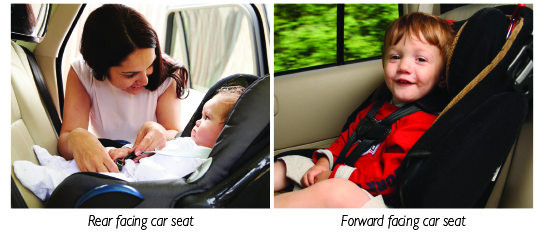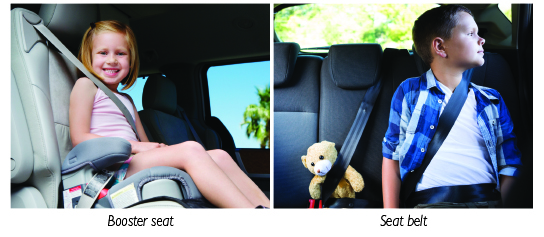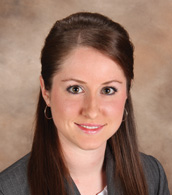Child Passenger
Safety
Nichole Marty, NP
Pediatrics
OakLeaf Pediatrics
Eau Claire
According to the Centers for Disease Control (CDC), motor vehicle injuries are a leading cause of death among children in the United States. In 2014, 602 children died and 121,350 were injured in motor vehicle crashes. However, a great number of these injuries and deaths can be prevented when children are properly restrained. The proper use of car seats reduces the risk of death by 71% for infants and 54% for toddlers. Unfortunately, child restraint systems are often used improperly. The CDC found that of 3,500 observed car and booster seats in one study, a whopping 72% were improperly used or installed.
Safety at Every Age
The first step in ensuring your child is properly restrained in your vehicle is knowing which child restraint system is appropriate based on the age of your child.

Infants and toddlers should be in a rear facing car seat until they are at least two years of age or until they reach the weight or height allowed by their car seat manufacturer; whichever is later. The longer your child is in a rear facing seat, the better. There are two types of rear facing car seats:
Infant only — these seats are only meant to be used in the rear facing position. These generally have a weight limit between 25 and 35 pounds and can be easily taken in and out of the vehicle.
Convertible — These function as both rear
facing for infants and forward facing for toddlers.
Most have a maximum rear facing weight limit
of 40 pounds and a forward facing weight limit
of 65 pounds.

Toddlers and preschoolers who have outgrown their rear facing seat should be transitioned into the forward facing position in their convertible car seat or forward facing with harness car seat.
School aged children who have reached the maximum weight limit for their convertible or forward facing car seat should be moved into a booster seat. Many convertible car seats can be transformed into a high back or backless booster seat.
Older children can use the seat belt when they are old enough and large enough for it to fit them properly. Generally, this means they have reached 4 feet 9 inches in height and are at least 8 years of age. Remember, this is only a general guideline, some children may need to ride in a booster even though they have reached the above height and age milestones. In order for the seat belt to restrain the child properly in a crash, the shoulder portion of the belt must go across the chest and not the neck, and the lap portion must lie snugly across the upper thighs, not the stomach.
It is important to remember that all children under the age of 13 should ride in the back seat because it’s much safer there.
Car Seat Installation
Making sure that you have the correct restraint system for your child is just one part of ensuring your child is safe in your vehicle; installing the car seat correctly is just as important. An improperly installed car seat will not protect your child in the event of a crash. Car seat installation can be confusing, but you don’t have to do it alone. You can get your child’s car seat inspected by a certified car seat technician at one of the many car seat safety check events across Wisconsin. Car seats are checked for proper size and installation, and you will be notified of any possible recalls. You’ll learn about how to correctly use your car seat, and how to ensure proper seat belt fit for older children. To find the date and time of a car seat check near you, go to www.wcpsa.com and click on “where to have seats checked.”
Common Mistakes
Car seat too loose
According to car seat safety inspectors, this is the number one mistake parents make. Grasp the car seat base and attempt to move it in all directions. You shouldn’t be able to move the seat base more than one inch to the left, right or forward. If you find that the base is too loose, refer to your car seat’s instruction manual for instructions on how to tighten.
Bulky coat
Parents are often surprised to find out that bulky winter coats are not supposed to be worn underneath the harness of the car seat. Wearing a bulky coat can result in the harness being too loose to be effective in the event of a crash. Parents should take the child’s coat off, secure the child in the car seat and then turn the coat around and put it on backward with their arms through the arm holes and the back of the coat acting like a blanket.
Harness is too loose
After securing your child in the seat, attempt to pinch the fabric of the strap where it comes over the shoulder. If you are able to pinch it between your fingers, the harness is too loose. The straps should be snug and have no slack.
 Incorrect retainer clip placement
Incorrect retainer clip placement
The retainer clip should be at armpit level, resting across your child’s breastbone. If it is too low, your child could be ejected from the car seat in a crash.
Using a recalled car seat
To check if your seat has been recalled visit www.safercar.gov. Make sure you register your car seat with the manufacturer so you’ll be notified if there is a recall. Don’t buy a used car seat at a garage sale or second hand store; you don’t know if the seat was properly cared for or in an accident.
Nichole Marty – OakLeaf Pediatrics
For information or to schedule an appointment:
715-830-0732 | oakleafclinics.com
Nichole sees patients in Eau Claire.





 Incorrect retainer clip placement
Incorrect retainer clip placement